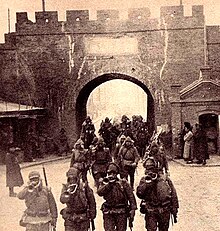Manchuria crisis
| date | September 18, 1931 - February 1932 |
|---|---|
| location | Manchuria , Republic of China |
| exit | Japanese victory |
| Territorial changes | all of Manchuria is occupied by Japan |
| Parties to the conflict | |
|---|---|
| Commander | |
| Troop strength | |
| 160,000 soldiers | 30,000 to 60,450 soldiers |
| losses | |
|
? |
? |
The 1931 Manchuria Crisis marked a crisis between Japan and the Republic of China prior to the Second Sino-Japanese War . As a result of the crisis, Japan occupied Manchuria and established the puppet state of Manchukuo in order to exploit the resource-rich region.
background
After the First Sino-Japanese War, Japan had gained Korea as a sphere of influence and was interested in the raw material deposits of Manchuria. By 1900 Russia occupied Manchuria. The tensions between the Russian Empire and Japan grew, culminating in the so-called Russo-Japanese War in 1904 . Japan won the war and Russia had to evacuate Manchuria, which was returned to China.
As a result, Japan increased its influence and built the South Manchurian Railway . The railway line was used to transport raw materials from Manchuria to Korea , which was annexed in 1910 , from where they were shipped to Japan. The railway was secured by the Kwantung Army . After the Great Depression, many Japanese military saw a solution to the country's problems in further expansion towards Manchuria. In the declaration of the "Cherry Blossom Society" (around the ideologist Kita Ikki ) of September 1930, the Japanese government and parliamentarians were accused of inaction in the face of agricultural and raw material problems. One solution would be agricultural reform in Japan and expansion in East Asia, especially China. The competition between the white imperialist powers must be overcome, according to the military Araki Sadao .
course

On September 18, 1931, a bomb attack was carried out on the South Manchurian Railway near the city of Mukden . This incident was called the Mukden incident . It is certain that this incident was orchestrated by the Kwantung Army .
The Kwantung Army immediately attacked the nearby Chinese garrison. The army's action was allegedly not planned by the Japanese government. Since China was already in the middle of a civil war and was militarily weak, the Japanese were able to take Manchuria by early 1932.
The puppet state of Manchukuo was established to administer Manchuria . At its head was Puyi , the former emperor of China .
follow
By attacking China, Japan broke three treaties, the League of Nations statutes , the Briand-Kellogg Pact and the Nine Powers Treaty . According to Hermann Graml, the system of collective security of the League of Nations had to pass its “ordeal by fire”, in which it failed its “first serious test”. The "fall of man" that Japan got away with without sanctions had fatal consequences. Without this demonstration of the weakness of the League of Nations and the Versailles system, Hitler would hardly have dared to leave the Geneva Conference on Disarmament and the League of Nations, which was a prerequisite for German rearmament . And Mussolini would not have made the decision to go to war against the Empire of Abyssinia , a member of the League of Nations.
The League of Nations appealed to by China merely protested in vain against Japan's actions and convened a commission to investigate, the Lytton Commission . The US declared the Hoover-Stimson Doctrine to be unjustified. The state of Manchukuo has only been recognized by a few states. In February 1933 the League of Nations adopted the Lytton Report against the vote of Japan, whereupon the country left the League of Nations on March 27th.
When Japan wanted to expand its sphere of influence further north, the Japanese-Soviet border conflict broke out in 1938/39 .
During the next few years there were further skirmishes between Japanese and Chinese troops until the incident at the Marco Polo Bridge on July 7, 1937 , which became the cause of the Second Sino-Japanese War .
Manchuria was conquered by the Soviet Union in Operation August Storm towards the end of World War II in 1945 and returned to China in 1946.
literature
- Maochun Yu: The Dragon's War: Allied Operations and the Fate of China, 1937-1947 . Naval Institute Press (Annapolis), 2006.
- Gottfried Karl Kindermann : The Far East , dtv-Weltgeschichte des 20. Jhs., Munich 1970, esp. Pp. 285-312.
Web links
Footnotes
- ^ Hermann Graml : The failure of international solidarity . In: Klaus Hildebrand , Jürgen Schmädeke , Klaus Zernack : 1939 - On the threshold of the world war. The unleashing of the Second World War and the international system . Berlin / New York 1990, p. 253.
- ↑ describes how above all France (Chapter 1), the Soviet Union (Chapter 2), Great Britain (4) and the USA (5) provided military aid and pursued interest-based politics.

